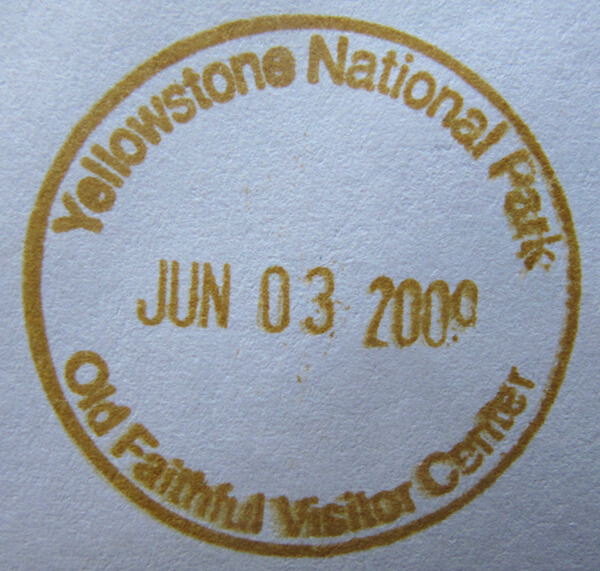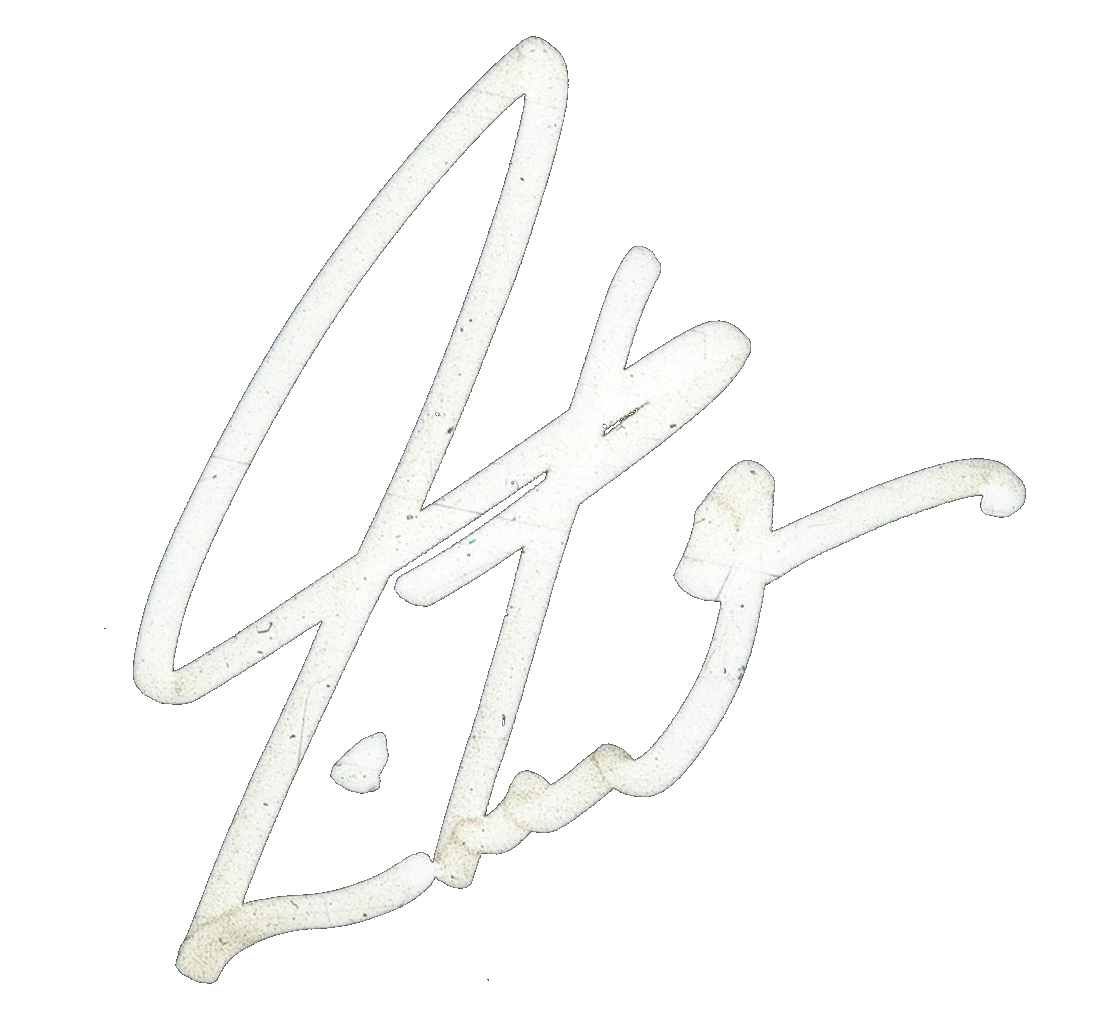[continued]
A little farther on I slowed to read a sign that forbade parking along that stretch of road, to protect the nest of a bald eagle. Puttering slowly past, I saw the immense structure of the nest high in a tree just off the road.
Continuing west, I crossed into Idaho, out of the park and into more open ranch country and sagebrush rangeland. The morning grew clear and sunny, warming fast, and I could make good steady time along country two-lanes with infinite visibility. I passed long security fences with dire warning signs, roadsigns pointing to the Idaho National Laboratory, and a turnoff to a place called Atomic City. Then I rode through a typical-looking ranch town called Arco, Idaho, and its sign caught my attention: “The First City in the World Lighted by Atomic Power.” Then I noticed a burger joint offering the “Atomic Burger.”
Curious, I made a mental note to look into that town’s story when I got home, and it proved to be an eye-opening piece of modern history. Arco began as a sagebrush cowtown fetchingly called Root Hog, until 1901, when the citizens moved the town to the banks of the Big Lost River, to put it at the junction of two stagecoach routes. They applied to the U.S. Post Office to name their new town “Junction,” but instead they were advised to name it after a German count, Georg von Arco, who happened to be visiting Washington, D.C., at the time. Coincidentally, the count went on to be a pioneer in radio and the founder of Telefunken, and his namesake town would play its part in modern technology, too.
In 1949, the National Reactor Testing Station was established nearby, in a remote high desert location that was perfect for secret government operations—in this case, to develop peacetime uses for nuclear energy. In 1955, ten years after the atomic bombs had leveled Hiroshima and Nagasaki, nuclear power lighted the streets of Arco.
The Miracle of the Atom seemed to offer such a bright and shining future, with clean, cheap, limitless energy powering cities, ships, submarines, airplanes, and cars. Strange to think that such a utopian vision was born right near that little town in Idaho.
Like national parks and philanthropy, nuclear power was another world-changing American invention, but its effects were obviously more . . . complicated. In 1985, I wrote the lyrics for a song called “Manhattan Project,” about the birth of the Atomic Age (“The big bang, took and shook the world/ Shot down the rising sun”). Unusually for the lyrics to a rock song, “Manhattan Project” required a great deal of research (in the days when research had to be done by reading a pile of books rather than pressing a few keys), and I learned a lot. Then I had to distill all of that knowledge into what would add up to only 167 words—and they had to be words that could be sung.
Once I had chiseled out a draft of what I wanted to convey, it wasn’t easy to “sell” the notion of a historical rock song, even to my bandmates. But it was Geddy, thinking as a singer, who suggested that I construct it so the listener was invited to imagine the scene. (Moments of collaboration like that are galvanizing in two ways—first that someone else likes your idea enough to take it seriously, then suggests a way to make it better.)
Imagine a time, when it all began
In the dying days of a war
Searching for a weapon
That would settle the score
Whoever found it first—would be sure to do their worst
They always had before
As early as 1939, Albert Einstein wrote a letter to President Roosevelt urging him to pursue atomic weapons, because Einstein and other scientists believed the Germans were already working on such a program (they were, but—in a prescient scenario—the scientists overestimated the enemy’s progress with such weapons of mass destruction).
Imagine a man
Where it all began
A scientist pacing the floor
In each nation—always eager to explore
To build the best big stick
To turn the winning trick
But this was something more
Modern revisionists seem to diminish the historical reality of that time—for example, the appalling brutality and racial genocide the Japanese had been inflicting in China, Korea, the Philippines, and elsewhere. Mass killings of civilians (tens of thousands at a time, and totaling at least twice the Holocaust’s grim toll), biological and chemical warfare, inhuman treatment of prisoners-of-war, slavery, forced prostitution, medical experiments without anesthetic, vivisection, cannibalism—it’s a horrific list. To absorb that history, added to Japan’s alliance with the Axis Powers and the devastating sneak attack on Pearl Harbor that began the War in the Pacific, is to share an outrage that would have deserved any level of vengeance, to make it stop, and to punish the perpetrators. Anyone who believes in the alternative—that the “humane” way to end World War II would have been an invasion of Japan—would only shift that death sentence to the American lives that such a suicide mission would have cost.
The big bang—took and shook the world
Shot down the rising sun
The end was begun—it would hit everyone
When the chain reaction was done
In the early ’90s, on a day-off on a concert tour, I visited Los Alamos, “where it all began,” and later that decade, on the Ghost Rider journey, I stopped at the Trinity Site in New Mexico, where the first tests were conducted. In the ’80s, on a concert tour of Japan, I had looked out from the bullet train passing through Hiroshima, and thought about what had happened there, and why. Now I was riding through what had been the next chapter in that story.

It happened that one of my camera’s settings got jostled in the tankbag, and I ended up with a series of unexpectedly artful Action Self Portraits taken in that region—red filtered out, while other colors were saturated. The effect does suggest the austerity, and serenity, of the high desert, a surreal emptiness that can seem other-worldly—especially when you learn its hidden secrets, like the story behind those streetlights in little Arco, where atomic energy was harnessed for the first time.
Alas, it would not be without human cost—in 1961, the reactor that had produced Arco’s electricity suffered a steam explosion and meltdown (human error), causing the world’s first peacetime nuclear fatalities—three of its workers. Comparable to the space program, perhaps, the progress of nuclear technology was slowed by human losses, but not halted, and reactors began to sprout around the world, powering electrical generators, ships, and submarines.
Then in 1979, a partial meltdown occurred at Three Mile Island in Pennsylvania (human error again). This time there were no fatalities, but unfortunately the accident occurred within two weeks of the release of a fictional movie called The China Syndrome, dramatizing just such an accident, using melodrama and pseudoscience to play on people’s fear of what they didn’t understand (a timeless strategy, in religion, politics, and entertainment).
Widespread hysteria ensued, fanned by self-appointed “experts” like the star of The China Syndrome, Jane Fonda, and the careerist fearmonger, Ralph Nader. The shrill reflex of the “no nukes” protests effectively ended the growth of nuclear energy in the Western world (though France quietly continues to produce three-quarters of its energy from reactors.)
In 1979, the chief voice of reason against that howling mob was another dubious character—the scientist Edward Teller. Teller was a veteran of the Manhattan Project, the “father of the H-bomb,” director of the Lawrence Livermore National Laboratory, and one inspiration for the character Dr. Strangelove in the movie of the same name (subtitled “How I Learned to Stop Worrying and Love the Bomb”). He was also the betrayer of Robert Oppenheimer, the leader of the Manhattan Project, and high on my personal list of “People of Interest.” (Oppenheimer took the name of the Trinity Site, in the desert near Alamagordo, New Mexico, from a sonnet by John Donne, and after the first test of the atomic bomb was successful, he contemplated a verse in Sanskrit, “Now I am become Death, the shatterer of worlds.”)
At a 1954 hearing to review Robert Oppenheimer’s security clearance (apparently threatened because of an unstable girlfriend with Communist associations), Edward Teller was asked whether he considered Oppenheimer a security risk. He replied that he had repeatedly seen Oppenheimer act “in a way which for me was exceedingly hard to understand,” then clinched it with a damning indictment: “To this extent I feel that I would like to see the vital interests of this country in hands which I understand better, and therefore trust more.”
In 1979, the public may have felt the same way about Edward Teller, as he stood up in counter-campaigns and tirelessly tried to correct misconceptions and widespread panic. But as ever, science and reason had little sway over fear and ignorance—or misguided movie stars and professional muckraking malcontents in bad suits. Teller suffered a heart attack that year, which he half-jokingly blamed on Jane Fonda: “You might say that I was the only one whose health was affected by that reactor near Harrisburg. No, that would be wrong. It was not the reactor. It was Jane Fonda. Reactors are not dangerous.”
Clearly, history has shown that Dr. Teller was a little over-optimistic there, but perhaps it was true that reactors were not as dangerous as some other threats to human life and well-being. Like, say, misguided movie stars and professional muckraking malcontents in bad suits—or the stripping away of entire mountaintops to dig up coal and foul the atmosphere by burning it.
A few years later, when I was writing “Manhattan Project” in 1985, the Cold War was still an international menace, and I was thinking of both nuclear weapons and nuclear energy in the second half of the chorus:
Big shots try to hold it back
Fools try to wish it away
The hopeful depend
On a world without end
Whatever the hopeless may say
I’m not sure if I intended that twist on “the hopeless,” but I like it.
In any case, the verdict was handed down in the supreme court of public opinion, and the “fallout” was that the pursuit of nuclear power, for purposes both peaceful and warlike, was abandoned to less developed, or less conscientious nations—soon leading to the true disaster of Chernobyl, in 1986 (the year after “Manhattan Project” appeared on our Power Windows album).
In the last years of a corrupt and crumbling Soviet empire, a clusterbomb of human and mechanical failures caused a terrible explosion, killing two workers instantly, several dozen fire and rescue workers immediately after, and releasing four hundred times the radioactive fallout of Hiroshima. An international committee estimated that the eventual toll from the radiation and associated cancers might reach a couple of thousand—terrible enough, of course, but even that number could never match the deaths from, oh, mining and burning coal, for example.
Not to mention the religiously-inspired terrorist attacks of September 11, 2001 . . .
But the “first world” had already reverted to a nineteenth-century dystopia of burning coal (as I have noted before, in another context, coal still produces more than half of America’s electricity). Shunning the perceived dangers of nuclear energy, people seemed less troubled by the “simple” idea of burning coal, despite its very real and insidious dangers (here—now—real), while governments remain suspiciously quiet about its contributions to climate change. At the same time, we turn a blind eye to the medieval institutions of superstition, feudal rule, and misogyny in tyrannical kingdoms like Saudi Arabia, because we “need” their oil.
And to think that those troubles had a large part of their history written more than fifty years ago, right around little Arco, Idaho . . .
Today, the National Reactor Testing Station is the Idaho National Laboratory, the immense fenced-in compound I had been passing for miles (it covers an incredible 890 square miles!). No wonder such enormous secret government installations give rise to paranoia—and later that same day I would be passing the mother of all those paranoid obsessions, Area 51 and the Extraterrestrial Highway.
But there were a lot of high-desert miles between the two—over 500, in fact. And a wall of strong wind, an invisible barrier that drove against me on the endless open stretches of the Great Basin. The wind’s power worked against my motorcycle’s, and I noticed that it was burning through fossil fuel unusually quickly. Where I can usually average 180 miles or more on a tankful, my reserve light came on at barely 100 miles. Even with my spare gallon can on the back, that could spell trouble in a region where gas stations were so far apart—where people were so far apart.
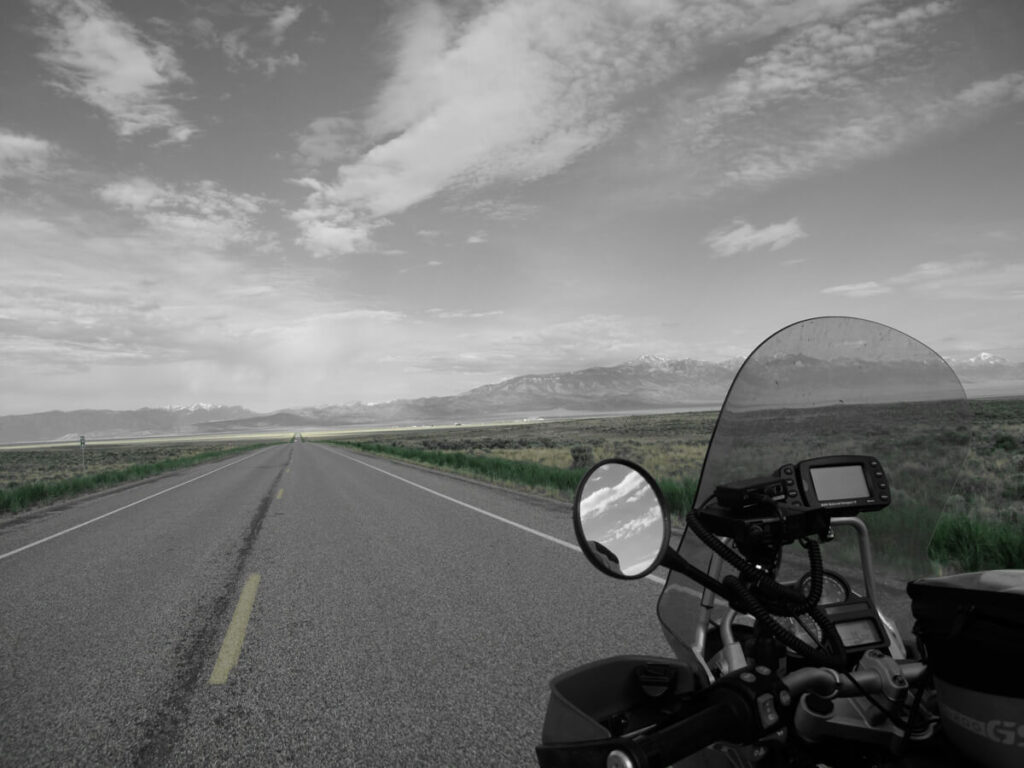
Riding through Arco, with its time-capsule feeling, both as a rural ranching town and for its “Atomic Burgers,” put me in mind of another Great Basin town, Ritzville, up in Washington state. A few miles later I found myself riding along and trying to put together the words of an old song, “Puttin’ on the Ritz.” That chorus, and the lines, “Dressed up like a million dollar trouper/ Trying hard to look like Gary Cooper (super duper)” were about all I could remember, except that the rest was complicated wordplay—but most of all I wondered why that song was in my head. The word for those songs or musical phrases that play over and over in your head derives from a German term that means “earworm,” and they can be a torment on a long motorcycle ride, like a mental mosquito.
For once, I was able to put it together—“Puttin’ on the Ritz” (Irving Berlin, 1929) was playing in my head because of Ritzville, and the Top Hat motel I had stayed at there in 2007 (see “Every Road Has its Toll”). It was nice to be able to trace the source of that earworm—like another one, earlier on this trip: riding up through southern Utah on the first day, I had wondered why I was hearing a reggae lilt, and singing, “Don’t gain the world and lose your soul/ Wisdom is better than silver and gold.” It was Bob Marley’s “Zion Train,” and I had just passed the exit for Zion National Park. The long-distance brain sometimes chooses its soundtrack in mysterious ways.
My only urban-traffic-and-construction obstacle that day was Twin Falls, Idaho, otherwise it was smooth sailing (on an upwind tack) all day. Down into Nevada on Highway 93 to Wells, gas up and buy a sandwich and a drink for later, strip off my inner layer (fifty degrees of temperature change by then, from the 30s to the 80s), then aim for Ely (“Elee”), battling that fierce wind, and stopping for occasional road-construction zones (a good opportunity to eat lunch). It didn’t look like my fuel would last until Ely, so I had to stop at McGill, though they only had regular gas. After Ely, with its Jailhouse Motel where Michael and I had stayed in 2007 on the way to a show in Salt Lake City, a sign on Highway 6 announced “No Gas For 167 Miles.” Again, that wouldn’t be a problem normally, but with that day’s wind, I was worried that even my spare gallon wouldn’t be enough to get me all that way to Tonopah.
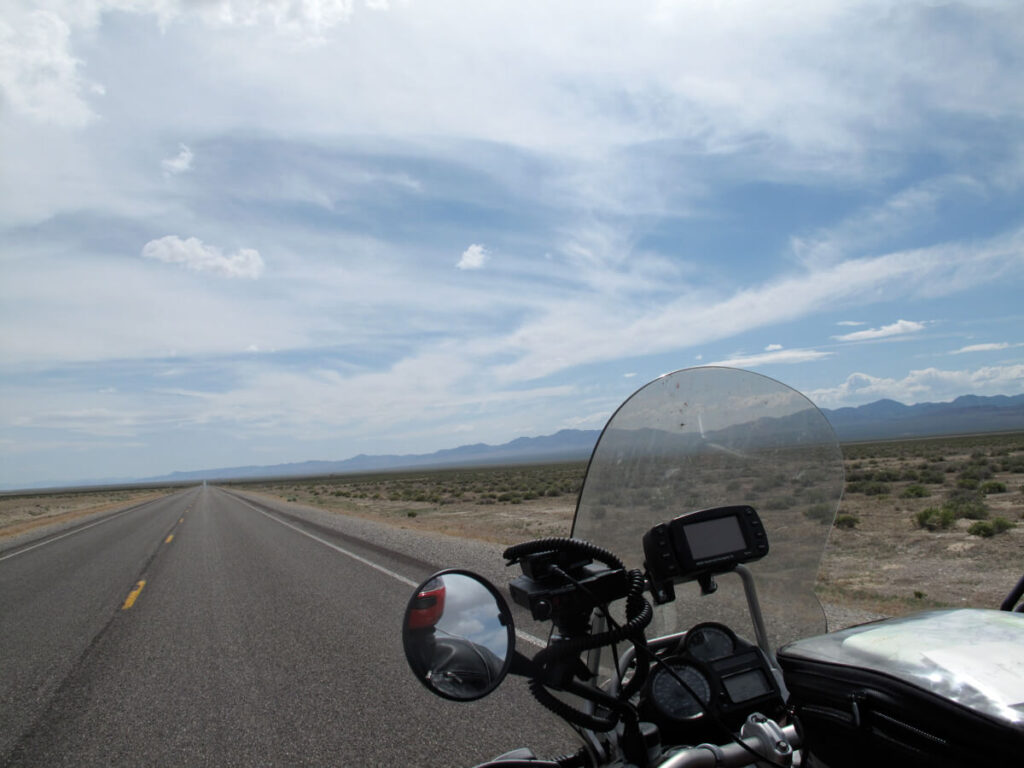
At a crossroads called Warm Springs, where the Extraterrestrial Highway met Highway 6, I stopped in the shade of an abandoned building to pour in that extra gallon. This was the exact spot, recounted in Ghost Rider, where Brutus and I had also found ourselves running out of gas, after a fast run from the Little Ale’Inn in Rachel, just to the east (next to the legendary Area 51, hence the café’s cringe-inducing name). That was in 1997, on the Test for Echo tour, and it was an early experience with the American West that taught many lessons—like the little red gas can that was saving me now.
Rachel had gas in those days (though not anymore, I noticed by a warning sign in that direction), but Brutus and I had looked at the map, saw Warm Springs at the next junction, and decided to carry on. At least the map I have now offers the printed word “(site)” after Warm Springs, to let you know it’s only a name, because there was nothing there—nothing but the boarded-up building I stopped beside this time. Back then, an old rancher hauling a horse trailer had pointed one way and said, “It’s about a hundred miles that way to Ely,” then turned and said, “And about fifty miles that way to Tonopah—nothing in between.”
Even twelve years later, someone was still maintaining that old cinder-block building, for some reason, and I saw where graffiti had been whitewashed over, leaving the red-painted letters spelling Warm Springs Bar & Cafe. A metal post remained where the pay-phone used to be—the one Brutus had used to try to call a gas station in Tonopah to come to our rescue. There had been no reply, and no choice but to keep going as long as we could, and maybe hitchhike the rest of the way.
A little farther west on Highway 6 we had come upon the Five Mile Ranch, and Brutus and I stopped and looked for someone who might sell us some gas. The place was deserted, but they had gas, and—at Brutus’s insistence, as I would never have had the nerve—we ended up leaving twenty dollars and a “sorry” note, then pumping a couple of gallons each (when gas was a buck-something, mind you) from their big metal tank.
This time I paused at the ranch’s gate and took a few photos to send to Brutus, then carried on to Tonopah. I had thought of stopping there, after covering 740 miles, but Tonopah was not a prepossessing town. A moribund desert mining settlement, it was now largely supported by a military installation, the Tonopah Test Range, part of the incredibly immense Nellis Air Force Range Complex, which also included the Nevada Test Site and the legendary Area 51 (altogether an unbelievable 4,700 square miles—half again the size of Yellowstone National Park). Nothing especially against the town of Tonopah—not so different from, say, Ely, where I always liked staying, but Tonopah lacked any attractive motels, however humble, or restaurants. I always thought of Tonopah, Nevada, as a town that was good for filling up with gas and riding away from—and sure enough, after stopping at the gas station and cruising Tonopah’s two highways, looking over the uninviting motels and restaurants, I said “phooey” (or words to that effect), and kept riding west. Even after all those hard, windy miles, somehow I was still feeling surprisingly fresh—tired and saddle-sore, yes, but not drowsy or crabby. All along I had been thinking about carrying on to somewhere more inviting, maybe Bishop, California—“only” another 130 miles, and I would gain an hour, crossing back into Pacific Time. Somehow that boost helped me talk myself into it (those can be contentious conversations).
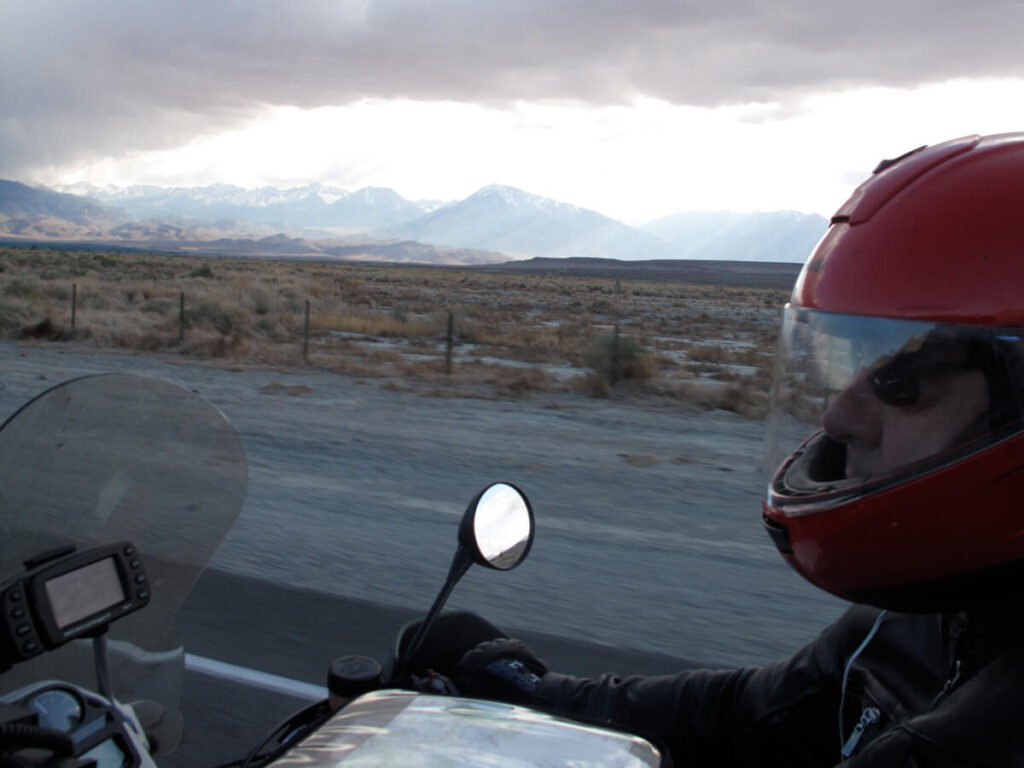
Another mountain town, at 4,137 feet, Bishop sits in the pretty Owens Valley, nestled between the high peaks of the Sierra Nevada on one side and the White Mountains on the other. As well as bringing me that much closer to home for the following day, Bishop offered a few decent motels and a fair choice of restaurants. After 877 miles that day, in fourteen hours, I was ready for one of those restaurants, and a Best Western bed.
From Bishop on, the roads home were familiar and well loved. I was able to keep to the two-lanes-only route, save where the highway occasionally widened to four lanes, and where I had to use a mile or two of interstate to connect to the excellent Lockwood Valley Road and Highway 33 to Ojai, then a short stretch of 101 through Ventura to the Pacific Coast Highway. Otherwise, all the way from Yellowstone to Los Angeles I stayed on back roads, covering 1,252 miles on the southward run—only about 150 miles farther than the interstate route, not more than an hour or two longer, and a whole lot more interesting and enjoyable.
Altogether, in those five days I rode 2,500 miles, and was glad to pull into my own garage, and get off that bike. As I have quoted myself before, “When I’m riding my motorcycle, I’m glad to be alive—and when I stop riding my motorcycle, I’m glad to be alive.”
That, I hope, will never change.
And I felt pretty good about the trip—despite all the rain, cold, and violent winds (and partly because of them), it had been an action-packed few days. My careful planning had paid off in all the important little ways, like the bike preparation, route planning, and wardrobe changes (I laughed when I was pleased to note that I’d had “all the right gloves,” always a critical detail in riding comfort—these days I carry three pairs, for hot dry weather, cool weather wet or dry, and cold wet weather).
Most of all, as I laid out my tools to change the bike’s oil, I had a feeling of Mission Accomplished—at last I had made it to Yellowstone National Park. I didn’t feel I had seen much of it, of course, but that green area on the map in the corner of Wyoming meant something to me now—it was on my “mental map,” at least, where it had not existed just one week before.
I can only hope that one day I will return to Yellowstone, maybe even to that little yellow cabin. And that wish gives rise to another line in iambic tetrameter—“If the fates are kinder, than they sometimes seem to be.”
That line too just cries out to be sung, perhaps in a triumphant chorus, with harmonized backing vocals:
If the fates are kinder, than they sometimes seem to be
(A little yellow cabin on Yellowstone Lake)
There will still be many journeys and adventures for me
(A little yellow cabin on Yellowstone Lake)
A million miles, a hundred songs in my head
(A little yellow cabin on Yellowstone Lake)
’Til the stupid fates decide it’s time to make me dead
(A little yellow cabin on Yellowstone Lake)
Yeah!
Now everybody . . .
